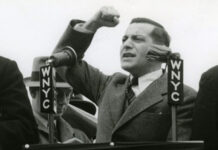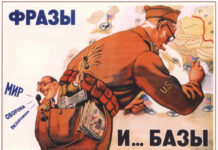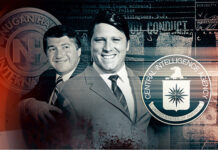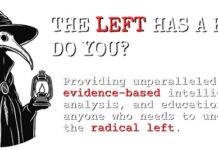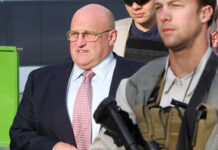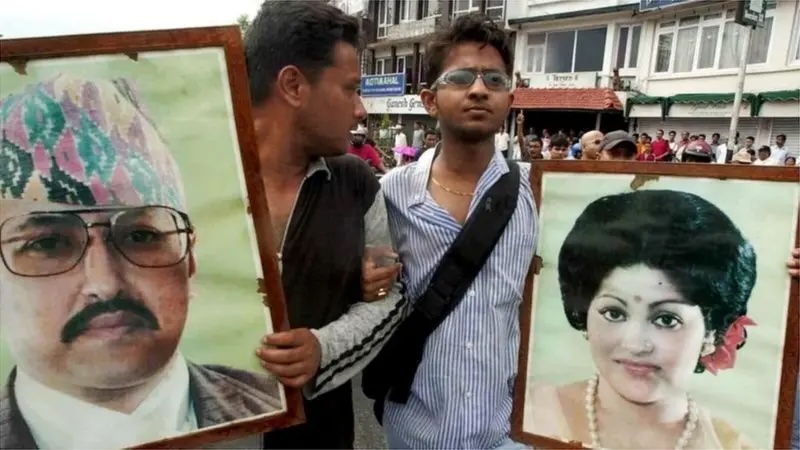
American Author Who Lived in Nepal Has Evidence Indicating That CIA and/or U.S. Special Forces Operatives Coordinated Slaughter of King and His Family and Then Covered It Up
[This article is part of CovertAction Magazine’s efforts to uncover the true history of the CIA that has been suppressed from the American public—Editors.]
On the night of June 1, 2001, a lovesick Nepali prince, fearing that he would be disowned if he went ahead with marriage to the daughter of a Nepalese politician, opened fire on his family with automatic rifles and killed the King and Queen along with eight other family members.
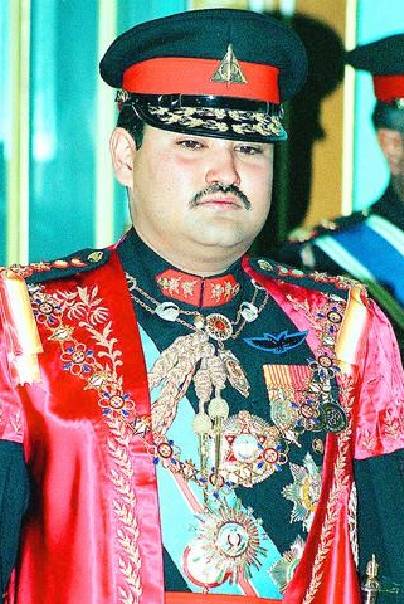
The Prince, Dipendra Bir Bikram Shah Dev, had a history of drug and alcohol abuse and was said to be intoxicated at the time. Dressed in military fatigues, he supposedly ran out of the family room after the killing spree and committed suicide by shooting himself in the head.
This official story of Nepal’s royalist massacre was put into question by the fact that some of the initial reports emphasized that, around the palace, there were night-flying helicopters—which Nepal did not have—and that there had been a shootout after which trucks filled with bodies were seen leaving the palace, with the bodies burned and ashes dumped in the Trishuli River.
Joseph R. Pietri is a hippie marijuana dealer who lived in Nepal for many years. In 2006, he published his memoir, The King of Nepal: Life Before the Drug Wars (Walterville, OR: TrineDay, 2006), which points out that, days before the Royalist massacre, a team of American military types, suspiciously, had checked into the Hyatt Hotel in Boudha.
The Americans told everyone that they were part of the crew working on a new hospital being built in Patan. However, these “Rambo-types stuck out like a sore thumb in Boudha,” according to Pietri, “and their military training stunk from their pores.”
Pietri asks: “Were they the advance team who guided the night-flying Black Hawk helicopters witnessed the night of the murders? Were they the first boots on the ground running communication between a privatized hit team that was going to assault the palace and wipe out the Royal Family?”
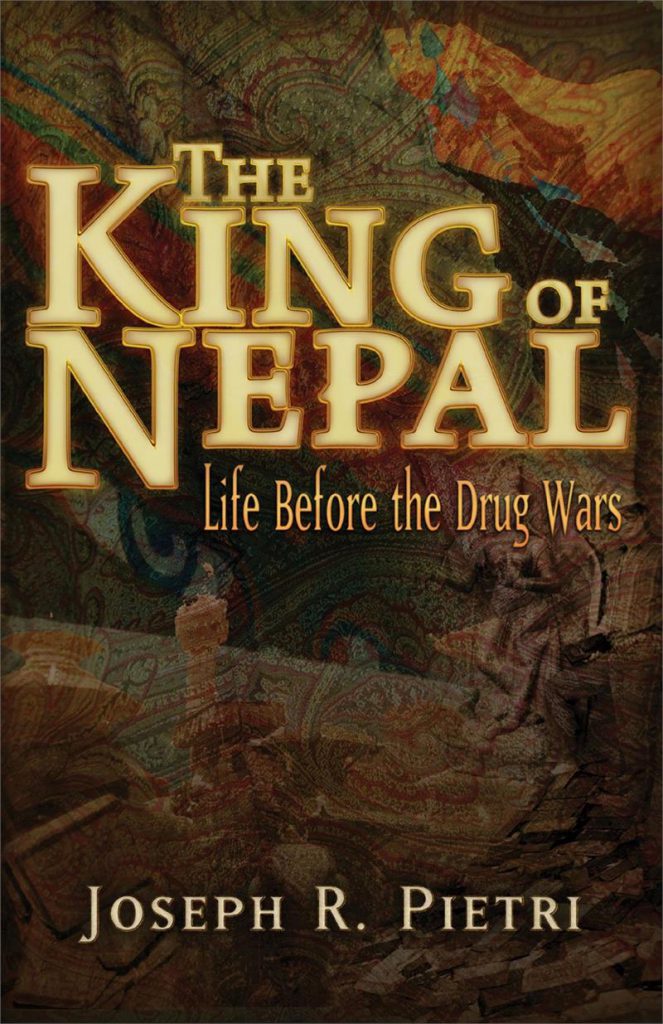
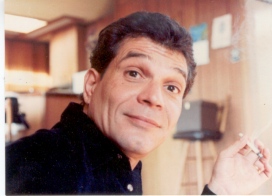
Pietri notes that, “as quickly as they appeared, the [Rambo-types] disappeared in the confusion of the murder days later, never to be heard or seen again in Nepal.”[1]
Pietri suggests as a motive the fact that the slaughtered King Birendra’s liberal political ideology and patriotism were seen as a weakness “in the eyes of imperialist and expansionist powers, i.e., India, the U.S., and the UK.”[2]
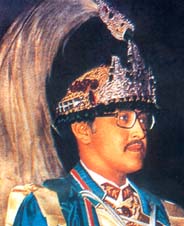
After the eruption of pro-democracy protests in Kathmandu in 1990, Birendra sided with the protesters and allowed formation of a “democratic monarchy,” legal political parties, and a parliament. King Birendra further refused to deploy the Royal Nepalese Army to crush the People’s Revolution that took root under the leadership of the Maoist Nepal Communist Party.
The Nepal Royal Family, as Pietri points out, had a long relationship with the CIA going back to the early 1960s when CIA-trained Tibetan guerrillas, fighting the Chinese, used Lo Mustang [Lo Manthang] on the border of Nepal as a base camp.
The CIA supported Tibet’s secessionist movement in an attempt to weaken and destabilize Communist China, which had asserted national control over China’s economy and offered an alternative and attractive economic model that threatened to undermine U.S. capitalist interests.
The head of USAID was once stopped driving a truck loaded with weapons en route to the Tibetan guerrillas. With the right amount in bribes, the weapons reached their destination.[3]
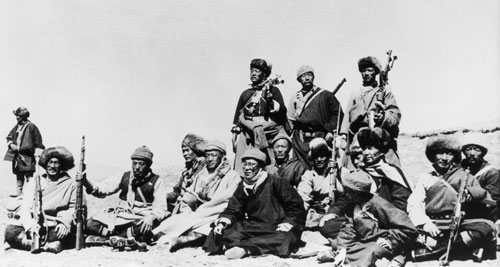
Pietri emphasizes that, within months of King Birendra’s murder on June 1, 2001, the Royal Nepalese Army was being equipped with advanced U.S. communication gear, weapons and U.S. soldiers as advisers.
American boys were seen flying choppers in support of government forces backed by the new King Gyanendra against the Maoist insurgency in a war that Pietri compares to Vietnam.[4]
Like in Vietnam, the Maoists came to control most of the countryside with the will of the people on their side.
The 2001 Royalist massacre was a blatant coup in which Crown Prince Dipendra was set up as a patsy à la Lee Harvey Oswald.
According to Pietri, Prince Paras Shah ran the bar at the Royal Palace the night of the massacre and drugged Prince Dipendra, who was then taken to Balaju Army Barracks where he was held as a bargaining chip in case the coup failed.[5]
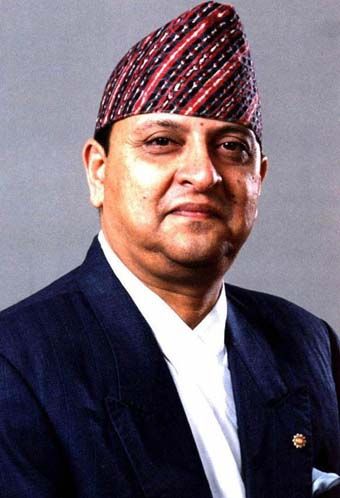
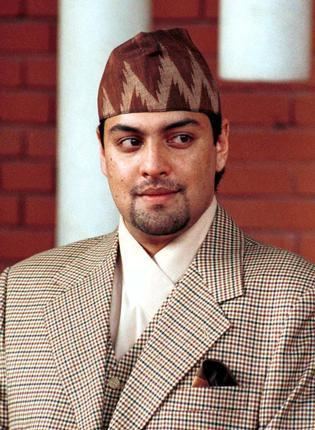
Black Hawk helicopters appeared from nowhere and teams wearing Nepalese face masks assaulted the palace with inside help. A shootout occurred and the palace guard was wiped out, along with anyone who was in the way of Gyenandra becoming King.[6]
Crown Prince Dipendra supposedly committed suicide by using his pistol to shoot himself in the head, yet the Prince was right-handed and he was shot in the left temple. He was most likely executed after the all-clear sign was given and his dead body was removed and taken to a military hospital, where it was said he was on life support, but was actually dead.[7]
Porters at the airport that night remember Gyanendra’s private jet waiting on the tarmac in case the coup failed and Gyanendra and his family were sent into exile. Pietri writes that “this was a completely planned and staged event that had the blessing and support of the governments of India, the UK, the U.S. and of course the Royal Nepalese Army.”[8]
Pietri added that, “since nobody in Nepal has the balls to kill their God King…the assassination was carried out by a private team of experts who took care of business and were gone before anyone knew what had happened. Everyone in the palace loyal to King Birendra was killed [and] the iron fist of Birendra’s father Mahendra, returned to Nepal.”[9]
Besides crushing the Maoists, the Nepal coup paid dividends for the U.S. after 9/11 when the new King Gyanendra “jumped on the War on Terror bandwagon” and allowed American Boeing B-52s to fly over the Himalayas on bombing runs over Afghanistan.[10]
Gyanendra further built a road from the Indian border through the Himalayas to Lo Mustang on the Tibetan Plateau, which was to serve as a planned forward base against China.
Under Gyanendra’s leadership, Pietri writes that Kathmandu took on the air of Saigon in the late 1960s as foreign troops engaged in urban warfare against the Maoist freedom fighters.
When a desperate King Gyanendra issued a royal decree seizing all power away from the people, the Maoists forced his abdication, resulting in the abolition of Nepal’s monarchy and empowerment of the Maoists.[11]
The 2001 U.S.-backed coup in Nepal, thus, was a failure in establishing a loyal proxy, like with many other U.S. military and CIA interventions since World War II.[12]
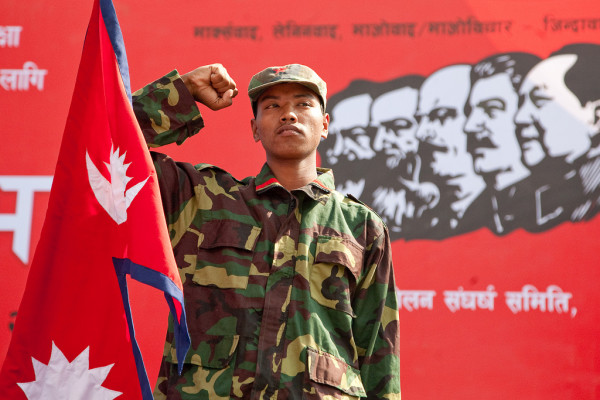
CIA Complicity in Asian Drug Trade
The CIA’s dubious involvement in Nepal extended to its support for the heroin traffic, which the Royal Family profited from since the 1960s, according to Pietri.
The Royals and Nepalese diplomats were not subject to customs, enabling them to move kilos of heroin around the globe through their embassies.[13]
The mob ran the gambling concessions at the Royal Family’s Soaltee Hotel, with a lot of the heroin funneled from Afghanistan and Pakistan into Nepal by the Nepalese army and police.
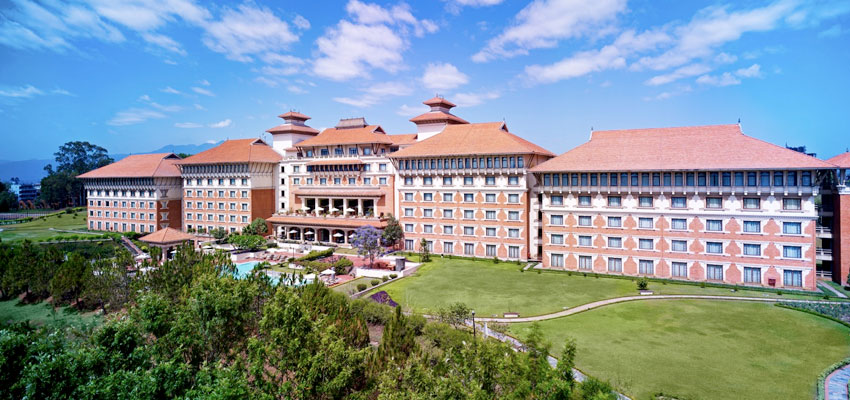
According to Pietri, Richard Nixon and his successors’ war on marijuana and hashish led to a boom in harder drugs such as cocaine and heroin, which Nepal’s Royal Family sought to cash in on.
King Mahendra’s brother, Prince Basundhara, owner of the Annapurna Hotel in Kathmandu, and the future King Gyanendra supplied Burmese heroin to members of the Royal Nepalese soccer team, which was deported for carrying 150 kilograms of China White heroin into Los Angeles airport at the 1984 Olympics.[14]
Pietri writes that the deportation was “all very hush-hush and only appeared in the news the day it happened, never to be heard from again until the publication of this book. The Nepalese never found [out] about this incident either, and a reporter who tried to expose the scandal was shot by the police.”[15]
In December 2005, Newsinsight Magazine reported that the FBI and DEA were investigating Crown Prince Paras for international drug running. The article suggested that the majority of the Royal Family was involved in the heroin trade and was never cleared in the assassination of King Birendra and his family in 2001.[16]
According to Pietri, King Gyanendra was a paid CIA agent who sold his soul to America as he established a worldwide syndicate for transporting and selling heroin that even made inroads into the lucrative East Coast heroin trade.
The DEA had turned a blind eye to the CIA’s activities in the drug trade throughout Asia, including its training of the Thai border police who ran the heroin and ganja trade, and Afghan mujahadin.
The War on Drugs was a complete farce, masking the U.S. government’s support for criminal syndicates whose utility lay in their advancement of American imperial ambitions.

-
Joseph R. Pietri, The King of Nepal: Life Before the Drug Wars (Walterville, OR: TrineDay, 2006), 204. ↑
-
Pietri, The King of Nepal, 203. ↑
-
Pietri, The King of Nepal, 202. ↑
-
Pietri, The King of Nepal, 204. ↑
-
Pietri, The King of Nepal, 205. ↑
-
Idem. The latter explains the removal of truckloads of bodies. ↑
-
Pietri, The King of Nepal, 205. ↑
-
Idem. ↑
-
Idem. ↑
-
Idem. ↑
-
Today Nepal continues to be led by the Communist Party. The Biden administration has recently been courting Nepal in an attempt to draw it away from China, which exhibits considerable influence there. ↑
-
See William Blum, Killing Hope: U.S. and CIA Military Interventions Since World War II (Monroe, ME: Common Courage Press, 1998). ↑
-
Pietri, The King of Nepal, 201, 202. ↑
-
Pietri, The King of Nepal, 201. ↑
-
Pietri, The King of Nepal, 113. ↑
-
Pietri, The King of Nepal, 202. ↑
CovertAction Magazine is made possible by subscriptions, orders and donations from readers like you.
Blow the Whistle on U.S. Imperialism
Click the whistle and donate
When you donate to CovertAction Magazine, you are supporting investigative journalism. Your contributions go directly to supporting the development, production, editing, and dissemination of the Magazine.
CovertAction Magazine does not receive corporate or government sponsorship. Yet, we hold a steadfast commitment to providing compensation for writers, editorial and technical support. Your support helps facilitate this compensation as well as increase the caliber of this work.
Please make a donation by clicking on the donate logo above and enter the amount and your credit or debit card information.
CovertAction Institute, Inc. (CAI) is a 501(c)(3) non-profit organization and your gift is tax-deductible for federal income purposes. CAI’s tax-exempt ID number is 87-2461683.
We sincerely thank you for your support.
Disclaimer: The contents of this article are the sole responsibility of the author(s). CovertAction Institute, Inc. (CAI), including its Board of Directors (BD), Editorial Board (EB), Advisory Board (AB), staff, volunteers and its projects (including CovertAction Magazine) are not responsible for any inaccurate or incorrect statement in this article. This article also does not necessarily represent the views the BD, the EB, the AB, staff, volunteers, or any members of its projects.
Differing viewpoints: CAM publishes articles with differing viewpoints in an effort to nurture vibrant debate and thoughtful critical analysis. Feel free to comment on the articles in the comment section and/or send your letters to the Editors, which we will publish in the Letters column.
Copyrighted Material: This web site may contain copyrighted material the use of which has not always been specifically authorized by the copyright owner. As a not-for-profit charitable organization incorporated in the State of New York, we are making such material available in an effort to advance the understanding of humanity’s problems and hopefully to help find solutions for those problems. We believe this constitutes a ‘fair use’ of any such copyrighted material as provided for in section 107 of the US Copyright Law. You can read more about ‘fair use’ and US Copyright Law at the Legal Information Institute of Cornell Law School.
Republishing: CovertAction Magazine (CAM) grants permission to cross-post CAM articles on not-for-profit community internet sites as long as the source is acknowledged together with a hyperlink to the original CovertAction Magazine article. Also, kindly let us know at info@CovertActionMagazine.com. For publication of CAM articles in print or other forms including commercial internet sites, contact: info@CovertActionMagazine.com.
By using this site, you agree to these terms above.
About the Author

Jeremy Kuzmarov holds a Ph.D. in American history from Brandeis University and has taught at numerous colleges across the United States. He is regularly sought out as an expert on U.S. history and politics for radio and TV programs and co-hosts a radio show on New York Public Radio and on Progressive Radio News Network called “Uncontrolled Opposition.”
He is Managing Editor of CovertAction Magazine and is the author of six books on U.S. foreign policy, including Obama’s Unending Wars (Clarity Press, 2019), The Russians Are Coming, Again, with John Marciano (Monthly Review Press, 2018), Warmonger. How Clinton’s Malign Foreign Policy Launched the U.S. Trajectory From Bush II to Biden (Clarity Press, 2023); and with Dan Kovalik, Syria: Anatomy of Regime Change (Baraka Books, 2025).
Besides these books, Kuzmarov has published hundreds of articles and contributed to numerous edited volumes, including one in the prestigious Oxford History of Counterinsurgency .
He can be reached at jkuzmarov2@gmail.com and found on substack here.


